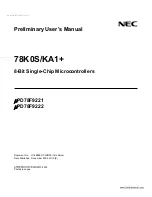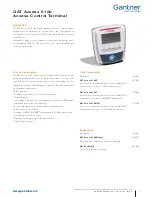
PHOENIX-60
PHOENIX-60
PHOENIX-60
PHOENIX-60
™
By
Castle Creations
60 amp Brushless Sensorless Speed Control
PHOENIX-60™ User
Guide
Page 3 of 6
Rev 5-date 11/11/03
This document, Phoenix-60™ software, and Phoenix-60™ PCB layout are all Copyright
2002-2003 by Patrick del Castillo and
Castle Creations
Warning!
High power motor systems can be very dangerous! High currents can heat wires and
batteries, causing fires and burning skin. Follow the wiring directions carefully! Model aircraft
equipped with high power motors can kill. Always fly at a sanctioned field. Never fly over or near
spectators. Even though this controller is equipped with a safety arming program, you should still use
caution when connecting the main battery.
8.0
Entering Programming Mode
The Phoenix-60™ software is designed to make it difficult to
accidentally
enter programming mode,
therefore it may seem like a long process to enter programming mode. This is to prevent entering
programming mode while preparing to fly or while in flight. To enter programming mode, follow the steps
below:
8.1
Verify Normal Operation
If this is the first time the Phoenix-60™ has been used, it is important to verify that the Phoenix-60™
operates normally with your transmitter otherwise programming may not function properly. Follow the
instructions in section 3.0 Initialization Sequence (steps 1-4). Once you have verified that the Phoenix-60™
operates normally, proceed to 8.2 below. If the Phoenix-60™ does not operate properly, see section 5.0,
Troubleshooting.
8.2
Enter Programming Mode
8.2.1
Remove battery power from the Phoenix-60™.
8.2.2
Move the transmitter stick to the
top
position (normally full “On”).
8.2.3
Reconnect battery power to the Phoenix-60™.
8.2.4
After approximately 2 seconds, the Phoenix-60™ will emit a short tone, and the LED on the
Phoenix-60™ should flash a short, single flash followed by a pause.
Phoenix-60™ responds: flash – pause
8.2.5
Move your transmitter stick to the
middle
position.
8.2.6
After approximately 2 seconds, the Phoenix-60™ will emit a short tone, and the LED on the
Phoenix-60™ should flash a short, double flash followed by a pause.
Phoenix-60™ responds: flash – flash – pause
8.2.7
Move your transmitter stick to the
top
position again.
8.2.8
After approximately 2 seconds, the Phoenix-60™ will emit a short tone, and the LED on the
Phoenix-60™ should flash a short, triple flash followed by a pause.
Phoenix-60™ responds: flash – flash – flash – pause
8.2.9
Move your transmitter stick back to the
middle
position again.
8.2.10
After approximately 2 seconds, the Phoenix-60™ will emit four short tones, and the LED on the
Phoenix-60™ will start a flash sequence of a single flash followed by another single flash,
followed by a long pause.
Phoenix-60™ responds: flash – flash – pause
8.2.11
The Phoenix-60™ is now in programming mode.
8.2.12
Proceed to Section 9.0 – Programming the Phoenix-60™
9.0
Programming the Phoenix-60™
Important Note
: When answering a question, you will need to move the transmitter stick to the yes (full
“On” throttle) position or the no (full “Off” throttle) position and keep it there for about 2 seconds. When the
Phoenix-60™ has accepted your answer, it will flash the LED rapidly. After the LED starts it’s rapid
flashing, move the throttle stick to the middle position to confirm that you are ready for the Phoenix-60™ to
ask the next question.
If you wish to re-program only some of the features you do not need to continue through the programming
steps for the remaining settings. Once you have programmed each of the features you wish to change and the
Phoenix-60™ has confirmed the selection, instead of returning to mid-throttle for the next question,
disconnect battery power, re-connect power, and arm the speed control as normal (see Section 3.0).
*Factory default settings are indicated by an asterisk in the option listings below.
9.1
Programming Setting 1 –Cutoff Voltage
Setting Recommended for use with: Setting Recommended for use with: _________________
Option 1: 4.0V cutoff voltage 5 cell NiCad or NiMH packs
Option 4: 7.2V cutoff voltage
9-12 cell NiCad or NiMH packs, or 3 cell Lithium packs
Option 2: 5.0V cutoff voltage* 6-8 cell NiCad or NiMH packs, or 2 cell Lithium packs
Option 5: 9.0V cutoff voltage
12-14 cell NiCad, 12-20 cell NiMH, or 4 cell Lithium packs
Option 3: 6.0V cutoff voltage 7-10 cell NiCad or NiMH packs
Option 6: 12.0V cutoff voltage
20 cell Nicad packs, or 4 cell Lithium packs
Phoenix-60™ Displays:
Programming Question Asked:
Your Response:
Phoenix-60™ Action:
Your Action:
Yes – Throttle stick in up position
Stores selection. Flashes rapidly to confirm receipt of
your response.
Return Tx stick to center and proceed to next setting–Current Limiting
(9.2 below)
1 flash – short pause – 1 flash – long pause
Setting 1 (cutoff voltage), Option 1
(4.0V)?
No – Throttle stick in off position
Flashes rapidly to confirm receipt of your response.
Return Tx stick to center and proceed to next option for this setting
Yes – Throttle stick in up position
Stores selection. Flashes rapidly to confirm receipt of
your response.
Return Tx stick to center and proceed to next setting–Current Limiting
(9.2 below)
1 flash – short pause – 2 flashes – long pause
Setting 1 (cutoff voltage), Option 2
(5.0V)?
No – Throttle stick in off position
Flashes rapidly to confirm receipt of your response.
Return Tx stick to center and proceed to next option for this setting
Yes – Throttle stick in up position
Stores selection. Flashes rapidly to confirm receipt of
your response.
Return Tx stick to center and proceed to next setting–Current Limiting
(9.2 below)
1 flash – short pause – 3 flashes – long pause
Setting 1 (cutoff voltage), Option 3
(6.0V)?
No – Throttle stick in off position
Flashes rapidly to confirm receipt of your response.
Return Tx stick to center and proceed to next option for this setting
























